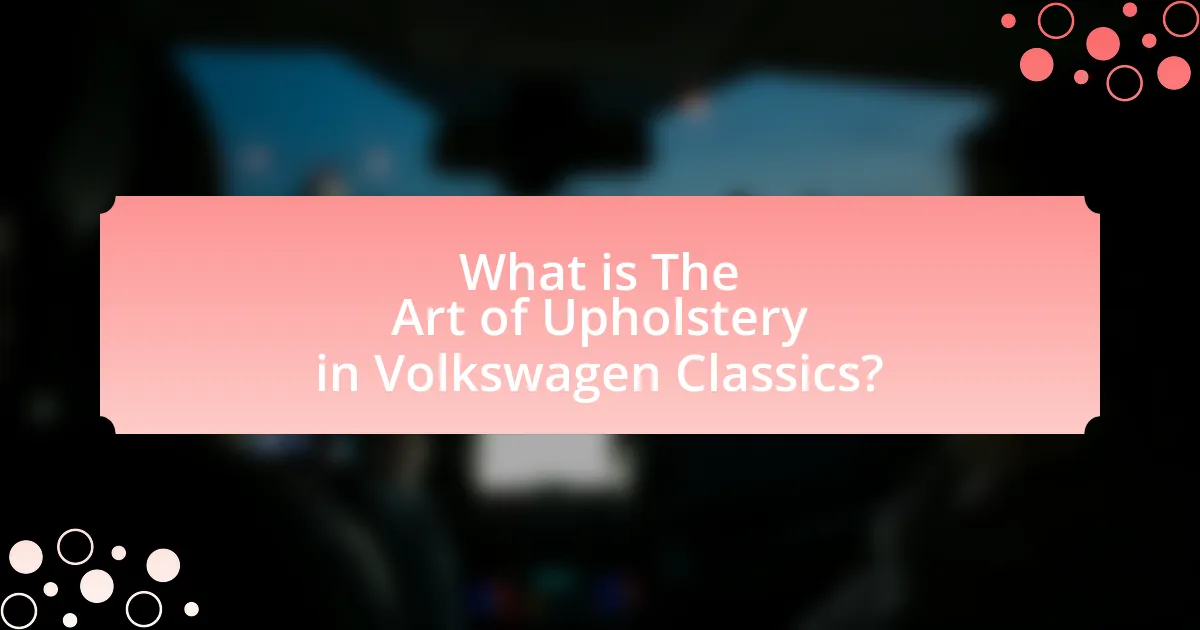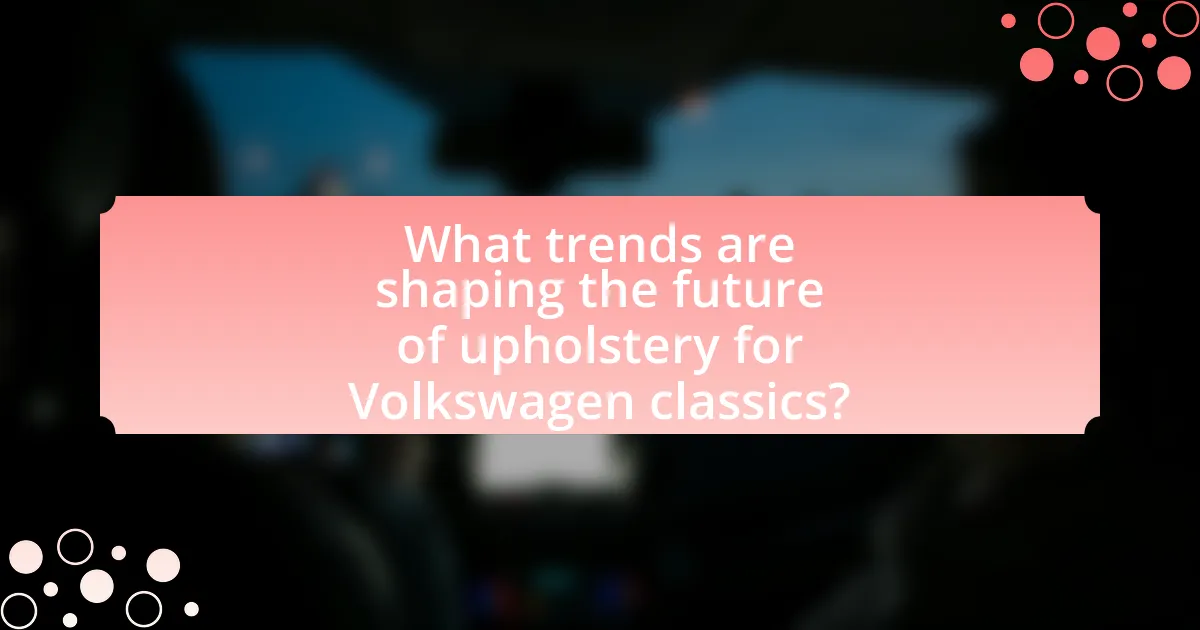The Art of Upholstery in Volkswagen Classics focuses on the specialized craft of designing and restoring the interiors of vintage Volkswagen vehicles. This article explores the significance of high-quality materials, craftsmanship, and historical accuracy in upholstery, highlighting how these elements enhance aesthetic appeal, comfort, and personalization. Key topics include the materials commonly used, the impact of fabric choice on aesthetics, the importance of custom upholstery for enthusiasts, and the techniques involved in the upholstery process. Additionally, the article addresses contemporary trends, challenges, and best practices for maintaining upholstery quality, providing valuable insights for Volkswagen classic car owners and restorers.

What is The Art of Upholstery in Volkswagen Classics?
The Art of Upholstery in Volkswagen Classics refers to the specialized craft of designing and restoring the interior fabric and cushioning of vintage Volkswagen vehicles. This art form emphasizes the use of high-quality materials, precise craftsmanship, and attention to historical accuracy, ensuring that the interiors not only enhance aesthetic appeal but also maintain the original character of the vehicle. Upholstery in this context often involves techniques such as sewing, padding, and fitting, which are tailored to match the specific model and year of the Volkswagen, thereby preserving its classic essence.
How does upholstery enhance the interior of Volkswagen classics?
Upholstery enhances the interior of Volkswagen classics by providing aesthetic appeal, comfort, and personalization. High-quality materials and craftsmanship elevate the visual and tactile experience, making the interior more inviting and luxurious. For instance, custom upholstery can incorporate vintage patterns and colors that reflect the era of the vehicle, thereby preserving its classic charm while also allowing for individual expression. Additionally, well-executed upholstery improves durability and wear resistance, ensuring that the interior remains in excellent condition over time. This combination of beauty, comfort, and longevity makes upholstery a crucial element in enhancing the overall experience of owning and driving a Volkswagen classic.
What materials are commonly used in Volkswagen upholstery?
Volkswagen upholstery commonly utilizes materials such as leather, vinyl, and fabric. Leather is often chosen for its durability and luxurious feel, while vinyl provides a cost-effective and easy-to-clean alternative. Fabric upholstery, which can include various blends, offers comfort and a range of aesthetic options. These materials are selected based on their ability to withstand wear and tear, maintain appearance, and provide comfort, aligning with Volkswagen’s commitment to quality and style in their classic models.
How does the choice of fabric impact the overall aesthetic?
The choice of fabric significantly impacts the overall aesthetic by influencing texture, color, and visual appeal in upholstery. Different fabrics, such as leather, cotton, or synthetic materials, create distinct looks and feelings; for instance, leather offers a luxurious and sophisticated appearance, while cotton can provide a more casual and inviting vibe. The color and pattern of the fabric also play crucial roles in defining the style of the interior, as vibrant patterns can add energy, while muted tones can evoke calmness. Additionally, the durability and maintenance of the fabric affect the long-term aesthetic, as high-quality materials tend to retain their appearance better over time, ensuring that the visual appeal remains intact.
Why is custom upholstery important for Volkswagen enthusiasts?
Custom upholstery is important for Volkswagen enthusiasts because it enhances the aesthetic appeal and comfort of their vehicles, allowing for personalization that reflects individual style. Enthusiasts often seek to restore or modify classic Volkswagen models, and custom upholstery plays a crucial role in achieving a unique interior that complements the vehicle’s overall design. Additionally, high-quality upholstery can improve durability and maintain the vehicle’s value, as evidenced by the fact that well-maintained interiors can significantly increase resale prices in the classic car market.
What are the benefits of personalized interiors?
Personalized interiors enhance the aesthetic appeal and functionality of a space, catering specifically to individual preferences and needs. By allowing customization, these interiors create a unique environment that reflects personal style, which can lead to increased satisfaction and comfort for the occupants. Studies show that personalized spaces can improve mood and well-being, as individuals feel more connected to their surroundings. Additionally, tailored interiors can optimize space utilization, ensuring that every element serves a purpose, which is particularly beneficial in classic vehicles like Volkswagen models where space is limited.
How does custom upholstery reflect individual style?
Custom upholstery reflects individual style by allowing personalization in fabric choice, color, and design, which directly aligns with a person’s aesthetic preferences. This customization enables individuals to express their unique tastes and lifestyles, particularly in the context of classic Volkswagen interiors, where options can range from vintage patterns to modern textures. The ability to select specific materials and styles not only enhances the visual appeal of the vehicle but also creates a sense of ownership and identity, making the car a true reflection of the owner’s personality.
What techniques are involved in the upholstery process?
The upholstery process involves several key techniques, including fabric selection, cutting, sewing, padding, and finishing. Fabric selection is crucial as it determines the aesthetic and durability of the upholstery; high-quality materials are often chosen for classic Volkswagen interiors. Cutting involves precise measurements and patterns to ensure a perfect fit for the vehicle’s contours. Sewing techniques, such as double stitching and using heavy-duty thread, enhance the strength and longevity of seams. Padding techniques, including the use of foam and batting, provide comfort and shape to the upholstered surfaces. Finally, finishing techniques, such as tufting and applying trim, add visual appeal and complete the overall look. These techniques collectively contribute to the craftsmanship and quality of custom upholstery in Volkswagen classics.
What are the steps in creating custom upholstery for Volkswagen classics?
The steps in creating custom upholstery for Volkswagen classics include measuring the existing seats, selecting appropriate materials, designing the upholstery pattern, cutting the fabric, sewing the pieces together, and finally installing the new upholstery. Accurate measurements ensure a proper fit, while material selection affects durability and aesthetics. Designing the pattern allows for customization, and cutting the fabric must be precise to avoid waste. Sewing requires skill to ensure quality seams, and installation completes the process, transforming the vehicle’s interior. Each step is crucial for achieving a professional finish that enhances the classic Volkswagen’s appeal.
How do skilled artisans ensure quality in upholstery work?
Skilled artisans ensure quality in upholstery work by employing meticulous craftsmanship, selecting high-grade materials, and utilizing advanced techniques. They begin by carefully assessing the specific requirements of each project, ensuring that the chosen fabrics and foams meet durability and aesthetic standards. Artisans often rely on traditional methods, such as hand-stitching and tailored fitting, which enhance the longevity and appearance of the upholstery. Additionally, they conduct thorough inspections throughout the process, checking for consistency in stitching, alignment, and finish. This attention to detail is supported by industry standards, which emphasize the importance of quality control in upholstery to achieve a professional and lasting result.

What are the key considerations for upholstery in Volkswagen classics?
Key considerations for upholstery in Volkswagen classics include material selection, authenticity, durability, and comfort. Material selection is crucial as it affects the overall aesthetic and longevity of the upholstery; high-quality fabrics or leather that match the original specifications are often preferred to maintain authenticity. Authenticity is vital for classic vehicles, as using original patterns and colors can enhance the vehicle’s value and appeal to collectors. Durability is important because upholstery must withstand wear and tear over time, especially in vintage models that may be used regularly. Lastly, comfort should not be overlooked, as the seating must provide adequate support for both driver and passengers during drives. These considerations ensure that the upholstery not only looks good but also performs well in a classic Volkswagen.
How do you choose the right upholstery style for your Volkswagen?
To choose the right upholstery style for your Volkswagen, assess your personal aesthetic preferences, the model’s vintage characteristics, and the intended use of the vehicle. Personal preferences guide the selection between classic, modern, or custom designs, while the model’s era influences fabric choices and patterns that align with its original style. For instance, a vintage Volkswagen Beetle may benefit from retro fabrics like tweed or vinyl, which reflect its historical context. Additionally, consider the vehicle’s use; if it’s for daily driving, durable materials like leather or synthetic options may be more practical. This approach ensures that the upholstery complements both your style and the vehicle’s identity.
What factors should influence your design choices?
Design choices for upholstery in Volkswagen classics should be influenced by functionality, aesthetics, historical accuracy, and material quality. Functionality ensures that the design meets the practical needs of the vehicle, such as comfort and durability. Aesthetics involve selecting colors and patterns that enhance the visual appeal while aligning with the classic style of Volkswagen models. Historical accuracy is crucial for maintaining the authenticity of the vehicle, which often requires research into original designs and materials used in specific models. Material quality impacts the longevity and maintenance of the upholstery, with high-quality fabrics and foams providing better wear resistance and comfort. These factors collectively ensure that the design not only looks good but also performs well and respects the heritage of the vehicle.
How can historical accuracy play a role in upholstery selection?
Historical accuracy significantly influences upholstery selection by ensuring that materials, patterns, and colors reflect the original designs of Volkswagen classics. For instance, using period-appropriate fabrics like tweed or vinyl, which were common in specific models during the 1960s and 1970s, maintains authenticity. This adherence to historical details not only enhances the aesthetic appeal but also preserves the vehicle’s value, as collectors often seek restorations that are true to the original specifications. Accurate upholstery choices can include specific stitching techniques and color palettes that align with the manufacturer’s original offerings, thereby reinforcing the vehicle’s historical integrity.
What common challenges arise during the upholstery process?
Common challenges during the upholstery process include fabric selection, precise measurements, and achieving a professional finish. Fabric selection can be difficult due to the need for durability and aesthetic appeal, particularly for classic Volkswagen interiors that require materials that match the original style. Precise measurements are crucial, as inaccuracies can lead to ill-fitting upholstery, which is especially problematic in vintage vehicles where original dimensions must be adhered to. Achieving a professional finish involves mastering techniques such as sewing, stapling, and tufting, which can be challenging for those lacking experience. These challenges are well-documented in upholstery guides and industry practices, emphasizing the importance of skill and attention to detail in producing high-quality results.
How can you overcome issues related to fit and finish?
To overcome issues related to fit and finish in upholstery for Volkswagen classics, ensure precise measurements and use high-quality materials. Accurate measurements prevent misalignment and gaps, while premium materials enhance durability and aesthetics. For instance, using automotive-grade fabrics and foams specifically designed for classic cars can significantly improve the overall appearance and longevity of the upholstery. Additionally, employing skilled craftsmen who understand the nuances of classic car interiors can lead to better results, as their expertise allows for meticulous attention to detail, ensuring that every seam and contour aligns perfectly.
What are the best practices for maintaining upholstery quality?
To maintain upholstery quality, regular cleaning and proper care are essential. Vacuuming upholstery weekly prevents dirt buildup, while spot cleaning spills immediately with a mild detergent helps avoid stains. Additionally, using fabric protectors can shield against wear and tear, extending the lifespan of the upholstery. According to the American Society of Interior Designers, maintaining a consistent cleaning schedule can significantly enhance the durability and appearance of upholstery, ensuring it remains in optimal condition over time.

What trends are shaping the future of upholstery for Volkswagen classics?
Sustainable materials are a key trend shaping the future of upholstery for Volkswagen classics. As environmental awareness increases, manufacturers and restorers are increasingly opting for eco-friendly fabrics, such as organic cotton, recycled polyester, and vegan leather alternatives. This shift not only reduces the carbon footprint associated with traditional upholstery materials but also appeals to a growing consumer base that values sustainability. Additionally, advancements in technology are enabling the development of durable, high-performance fabrics that maintain the classic aesthetic while offering modern functionality, such as stain resistance and UV protection. These trends reflect a broader movement towards responsible craftsmanship and innovation in the automotive restoration industry.
How is technology influencing upholstery design and materials?
Technology is significantly influencing upholstery design and materials by enabling the use of advanced fabrics, automated manufacturing processes, and innovative design software. For instance, the introduction of performance textiles, such as those that are stain-resistant and UV-protected, enhances durability and aesthetic appeal in upholstery for Volkswagen classics. Additionally, computer-aided design (CAD) software allows for precise customization and visualization of upholstery patterns, facilitating more intricate designs that were previously difficult to achieve. Furthermore, automated cutting machines improve efficiency and accuracy in fabric production, reducing waste and costs. These technological advancements collectively enhance the quality, functionality, and creativity of upholstery in automotive interiors.
What innovations are being introduced in upholstery techniques?
Innovations in upholstery techniques for Volkswagen classics include the use of sustainable materials, advanced digital printing, and 3D modeling technology. Sustainable materials, such as recycled fabrics and eco-friendly foams, are increasingly being utilized to reduce environmental impact while maintaining quality. Advanced digital printing allows for intricate designs and patterns to be applied directly onto upholstery fabrics, enabling customization that was previously difficult to achieve. Additionally, 3D modeling technology facilitates precise fitting and design, ensuring that upholstery fits seamlessly into the unique contours of classic Volkswagen interiors. These innovations enhance both the aesthetic appeal and functionality of upholstery in classic vehicles.
How do modern materials compare to traditional options?
Modern materials offer superior durability, lighter weight, and enhanced versatility compared to traditional upholstery options. For instance, synthetic fabrics like polyester and nylon resist stains and fading better than natural fibers such as cotton or wool, which can degrade over time. Additionally, modern materials often provide improved comfort through advanced cushioning technologies, such as memory foam, which adapts to body shape, unlike traditional materials that may lack such ergonomic features. These advancements are supported by industry trends showing a growing preference for synthetic materials in automotive upholstery due to their longevity and ease of maintenance.
What are the emerging styles in custom upholstery for classic cars?
Emerging styles in custom upholstery for classic cars include retro-modern blends, minimalist designs, and eco-friendly materials. Retro-modern blends combine vintage aesthetics with contemporary fabrics and techniques, appealing to enthusiasts who appreciate both nostalgia and modern comfort. Minimalist designs focus on clean lines and simplicity, often utilizing monochromatic color schemes to enhance the classic car’s original features. Eco-friendly materials, such as recycled fabrics and sustainable leather alternatives, are gaining popularity as consumers become more environmentally conscious. These trends reflect a shift towards personalization and sustainability in the classic car restoration market.
How do contemporary designs integrate with classic aesthetics?
Contemporary designs integrate with classic aesthetics by blending modern materials and techniques with traditional forms and styles. This integration often involves using innovative upholstery fabrics that enhance durability while maintaining the vintage look, such as high-performance synthetic materials that mimic the appearance of classic textiles. Additionally, contemporary designs may incorporate minimalist lines and functional elements that respect the original design ethos of classic vehicles, ensuring that the overall aesthetic remains cohesive. For instance, custom interiors for Volkswagen classics often feature sleek, modern seating arrangements that complement the iconic shapes of the original models, thereby preserving their historical significance while appealing to modern sensibilities.
What influences are driving changes in upholstery trends?
Changes in upholstery trends are primarily driven by consumer preferences for sustainability, technological advancements, and evolving design aesthetics. The increasing awareness of environmental issues has led consumers to favor eco-friendly materials and production methods, prompting manufacturers to innovate with sustainable fabrics and processes. Additionally, advancements in technology, such as digital printing and smart textiles, have expanded design possibilities, allowing for more personalized and functional upholstery solutions. Lastly, shifting design aesthetics, influenced by contemporary art and cultural movements, have led to a demand for unique textures, colors, and patterns that reflect individual style. These factors collectively shape the direction of upholstery trends in the market.
What tips can help you achieve the best results in Volkswagen upholstery?
To achieve the best results in Volkswagen upholstery, focus on using high-quality materials specifically designed for automotive applications. Selecting durable fabrics and foams that can withstand wear and tear is essential, as they enhance both the aesthetic and longevity of the upholstery. Additionally, proper measurements and templates should be taken to ensure a precise fit, which minimizes wrinkles and misalignments during installation. Following manufacturer guidelines for installation techniques, such as using the correct adhesives and tools, will further ensure a professional finish. Research indicates that using materials like marine-grade vinyl can significantly improve resistance to fading and moisture, making them ideal for classic Volkswagen interiors.
How can you ensure a successful collaboration with an upholstery professional?
To ensure a successful collaboration with an upholstery professional, clearly communicate your vision and requirements from the outset. Establishing a detailed project brief that outlines your design preferences, budget, and timeline fosters mutual understanding and sets expectations. Additionally, providing reference images or samples can help the professional grasp your aesthetic goals. Regular check-ins throughout the project can facilitate adjustments and ensure alignment with your vision. Research indicates that effective communication is a key factor in successful collaborations, as it minimizes misunderstandings and enhances satisfaction with the final outcome.
What maintenance practices will prolong the life of your upholstery?
Regular cleaning and proper care are essential maintenance practices that will prolong the life of your upholstery. Vacuuming upholstery weekly removes dirt and debris that can cause wear, while spot cleaning spills immediately prevents stains from setting. Additionally, using fabric protectors can create a barrier against spills and dirt, further extending the lifespan of the material. According to the American Home Furnishings Alliance, regular maintenance can increase the longevity of upholstery by up to 50%.


